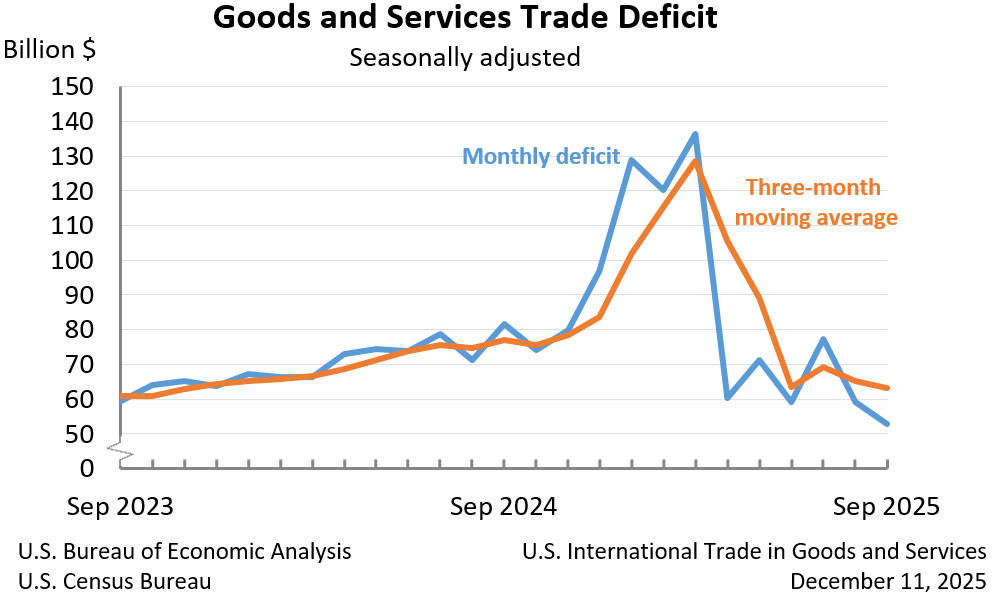Bureau of Economic Analysis
U.S. International Trade in Goods and Services, September 2025
The U.S. goods and services trade deficit decreased in September 2025 according to the U.S. Bureau of Economic Analysis and the U.S. Census Bureau. The deficit decreased from $59.3 billion in August (revised) to $52.8 billion in September, as exports increased more than imports. The goods deficit decreased $7.1 billion in September to $79.0 billion. The services surplus decreased $0.6 billion in September to $26.2 billion.
Principal Federal Economic Indicators
Noteworthy
The Latest
September 2015 Trade Gap is $40.8 Billion
The U.S. monthly international trade deficit decreased in September 2015 according to the U.S. Bureau of Economic Analysis and the U.S. Census Bureau. The deficit decreased from $48.0 billion in August (revised) to $40.8 billion in September, as exports increased and imports decreased. The previously published August deficit was $48.3 billion. The goods deficit decreased $7.3 billion from August to $60.3 billion in September. The services…
U.S. International Trade in Goods and Services, September 2015
U.S. Census Bureau U.S. Bureau of Economic Analysis NEWS U.S. Department of Commerce * Washington, DC 20230 U.S. INTERNATIONAL TRADE IN GOODS AND SERVICES SEPTEMBER 2015 The U.S. Census Bureau and the U.S.
Real Consumer Spending Increases in September
Personal income increased 0.1 percent in September, after increasing 0.4 percent in August. Wages and salaries, the largest component of personal income, remained flat in September after rising 0.5 percent in August.
Current-dollar disposable personal income (DPI), after-tax income, increased 0.1 percent in September after increasing 0.4 percent in August.
Real DPI, income adjusted for taxes and inflation, increased…
Personal Income and Outlays, September 2015
Personal income increased $18.6 billion, or 0.1 percent, and disposable personal income (DPI) increased $19.2 billion, or 0.1 percent, in September, according to the Bureau of Economic Analysis. Personal consumption expenditures (PCE) increased $15.6 billion, or 0.1 percent. In August, personal income increased $54.9 billion, or 0.4 percent, DPI increased $49.5 billion, or 0.4 percent, and PCE increased $44.2 billion, or 0.4 percent, based on…
GDP Increases in Third Quarter
Real gross domestic product (GDP) increased 1.5 percent in the third quarter of 2015, according to the “advance” estimate released by the Bureau of Economic Analysis. In the second quarter, real GDP increased 3.9 percent.
GDP highlights The third-quarter increase in real GDP mainly reflected a rise in consumer spending. Spending on services increased, notably on health care. Spending on nondurable and durable goods also rose.
Gross Domestic Product, 3rd quarter 2015 (advance estimate)
Real gross domestic product -- the value of the goods and services produced by the nation’s economy less the value of the goods and services used up in production, adjusted for price changes -- increased at an annual rate of 1.5 percent in the third quarter of 2015, according to the "advance" estimate released by the Bureau of Economic Analysis.
Guest Blog: Spending on Disease Treatment has Increased, but Good Health Outcomes Have Too
by Cynthia Cox Kaiser Family Foundation
(This post, from the Kaiser Family Foundation, is based on BEA’s new health care statistics released earlier this year.)
Coming Soon: Webinar for BE-180 Survey Respondents
The Bureau of Economic Analysis (BEA) will be conducting an informational webinar on Thursday, October 22, at 1 p.m., to discuss the BE-180 Benchmark Survey of Financial Services Transactions between U.S. Financial Services Providers and Foreign persons. Topics of discussion will include:
August 2015 Trade Gap is $48.3 Billion
The U.S. monthly international trade deficit increased in August 2015 according to the U.S. Bureau of Economic Analysis and the U.S. Census Bureau. The deficit increased from $41.8 billion in July (revised) to $48.3 billion in August, as exports decreased and imports increased. The previously published July deficit was $41.9 billion. The goods deficit increased $6.6 billion from July to $67.9 billion in August. The services surplus increased…
U.S. International Trade in Goods and Services, August 2015
U.S. Census Bureau U.S. Bureau of Economic Analysis NEWS U.S. Department of Commerce * Washington, DC 20230 U.S. INTERNATIONAL TRADE IN GOODS AND SERVICES AUGUST 2015 The U.S. Census Bureau and the U.S.




